|
|
|
Sort Order |
|
|
|
Items / Page
|
|
|
|
|
|
|
| Srl | Item |
| 1 |
ID:
127630
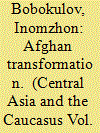

|
|
|
|
|
| Publication |
2013.
|
| Summary/Abstract |
This article examines the Afghan transformation that has been manifesting itself in such spheres as security, politics, and the economy. It is fed by the withdrawal of the international forces from Afghanistan. But, according to the author, this process, which is of an all-encompassing and systemic nature, is having a direct effect on the key aspects of society's vital activity, as well as, due to Afghanistan's particular geopolitical position, on the situation in Central and South Asia. Political and ethnic fragmentation is the main component in the current internal Afghan situation.
|
|
|
|
|
|
|
|
|
|
|
|
|
|
|
|
| 2 |
ID:
127642
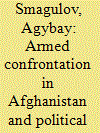

|
|
|
|
|
| Publication |
2013.
|
| Summary/Abstract |
The author looks at how the armed confrontation in Afghanistan affects the political and economic situation in Central Asia.
First, Afghanistan, which became a seat of international terrorism and religious extremism, as well as a foothold of the armed Tajik and Uzbek opposition in the 1990s, has developed into the real threat of a violent regime change in Tajikistan and Uzbekistan. In Tajikistan, the U.N. and certain other regional countries acting as intermediaries have successfully integrated the opposition into the country's peaceful development. The Uzbek opposition fighting on the side of the Taliban has been considerably weakened by the international counterterrorist coalition.
A compromise was reached in Tajikistan through constitutional amendments that legalized the Islamic party; on the other hand, we cannot rule out the possibility that in a country with a predominant Muslim population, Islam, a legal political factor, might come to power through democratic elections (this has already happened in Egypt).
The leaders of Uzbekistan chose a different road: instead of negotiations and compromises, they squeezed the armed opposition out of the country to Afghanistan. Operation Enduring Freedom practically reduced to naught the threats of extremist attacks very real in 1999 and 2000.
The coming pull-out of the international coalition troops from Afghanistan and inevitable bout of civil war that will ensue are causing concern in the Central Asian states: their far from simple social and economic context might raise a high wave of Islamic radicalism.
Second, instability in Afghanistan prevents diversification of foreign economic ties; it makes the construction of southward highways and railways, as well as power lines and gas pipelines, impossible. Afghanistan remains an insurmountable barrier on the trade route between the Central Asian countries and Kazakhstan, on the one hand, and the South Asian and Middle Eastern countries, on the other, and (which is even more important) blocks access to their sea ports.
The counterterrorist operation that began in 2001 failed: the United States is pulling out of the country leaving behind the same "Afghan threat," which is causing the Central Asian states to look to Russia and China as possible guarantors of their security.
|
|
|
|
|
|
|
|
|
|
|
|
|
|
|
|
| 3 |
ID:
127636
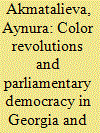

|
|
|
|
|
| Publication |
2013.
|
| Summary/Abstract |
The media of Kyrgyzstan described Georgia after the Rose Revolution of 2003 as a country that has made giant strides in economic recovery, suppressing corruption, and reform of its police and education system. The two countries increased their cooperation after the Tulip Revolution of 2010 in Kyrgyzstan; today, it has taken the form of an exchange of diplomatic and political experience and youth programs. Trade turnover between the two countries is expected to top $1.4 million.
These two Soviet successor-states, which adhere to different sociocultural and economic traditions, chose a practically identical road leading first to the presidential form of government and then to parliamentary democracies. This choice made after the color revolutions of 2003 in Georgia and 2005 and 2010 in Kyrgyzstan was suggested by the universal model of democracy that had gained popularity all over the world and was primarily a mechanism for legitimizing the power of the new people inside and outside the country. So far, parliamentary democracy in both countries has not developed enough to produce unambiguous results. It is much more important to understand how the changes were accepted and substantiated through an analysis of public discussions, discussions in the media and on the Internet, as well as in official documents, interviews, and statements by the leaders.
|
|
|
|
|
|
|
|
|
|
|
|
|
|
|
|
| 4 |
ID:
127632


|
|
|
|
|
| Publication |
2013.
|
| Summary/Abstract |
Today, when democracy is in crisis, the developing countries are finding the stronger global and regional integration processes much more important than before. This is largely true of the post-Soviet countries which, having entered a new development stage, are coping with the globalization challenges through structural transformations. The Republic of Armenia is one of them.
Throughout the 25 years of its independence, Armenia has been consistently moving toward a free democratic society irrespective of numerous problems in all spheres, including its foreign policy sphere. Its national security problems are resolved by its military-strategic relations with Russia, which has formulated the idea of the EurAsEC as a common economic expanse to counterbalance the EU. Moscow is putting pressure on all the CIS countries (Armenia among them) in an effort to draw them into this new structure which, in the near future, is expected to develop into the Eurasian Union.
European integration is a foreign policy priority in Armenia. The European political establishment, in turn, is demonstrating a far from adequate approach, to say the least, toward Armenia's possible EurAsEC membership. The Europeans make no secret of their intention to put pressure on Armenia, not only to prevent its membership in the Eurasian Union, but also to weaken Russia's influence in the Southern Caucasus and fortify their own positions in the south of the post-Soviet space and the Middle East.
The far from simple choice between the EurAsEC and the EU is proving to be a durability test in complementarism.
|
|
|
|
|
|
|
|
|
|
|
|
|
|
|
|
| 5 |
ID:
127637
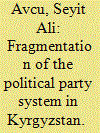

|
|
|
|
|
| Publication |
2013.
|
| Summary/Abstract |
A political party system is the nature and relations of the political parties in a given political system. There are four main variables in the classification of party systems: the extent to which parties penetrate society, the ideologies of the parties, the stance of the parties toward the legitimacy of the regime, and the number of parties in the system. The number of parties determines the level of fragmentation of the party system. Kyrgyzstan emerged as an independent country after the collapse of the Soviet Union. After two revolutions, which resulted in the ousting of the presidents, Kyrgyzstan officially changed its political system by announcing the introduction of parliamentary democracy and held its first elections after the regime change in October 2010. Five parties were able to pass the 5% national threshold to gain seats in the parliament. However, no single party gained enough of a majority to form the government on its own. Therefore, they formed coalitions, the latest of which includes three parties-the SDPK, Ar-Namys, and Ata-Meken-while the other two remained in the opposition: Respublika and Ata-Jurt. I estimated the effective number of parties by votes and seats and the least squares index for the 2010 parliamentary elections using Michael Gallagher's index, which utilizes the Laakso-Taagepera formula. The effective number of parties' index in Kyrgyzstan in terms of seat distribution in the Jogorku Kenesh was 4.90 for the 2010 parliamentary elections. However, the effective number of parties' index in terms of votes received by the parties is much higher: 9.86. On the other hand, the least squares index, which measures the disproportionality of the election results, is 13.75, which indicates the existence of many small parties with no seats. The 5% national threshold played a role in this disproportionality. The thesis of this article is that Kyrgyzstan's political party system is highly fragmented, and both institutional factors, such as constitutional and political party laws and the electoral system, and structural factors, such as social and political cleavages, play a role in this fragmentation.
|
|
|
|
|
|
|
|
|
|
|
|
|
|
|
|
| 6 |
ID:
127628
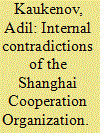

|
|
|
|
|
| Publication |
2013.
|
| Summary/Abstract |
In recent years, China has perceptibly strengthened its position in Central Asia largely due to the multisided cooperation format embodied by the Shanghai Cooperation Organization (SCO). From Beijing's perspective, it is not only a key organization, but essentially a regional integration project. Moreover, Central Asia's development is closely tied to the development of Xinjiang, in which the Chinese leadership is making large investments in order to eliminate the separatist moods in this unsettled region. Nevertheless, the SCO has substantial systemic contradictions that the new CPR leadership headed by Xi Jinping is trying to overcome.
The West initially had a passive attitude toward the SCO. At that time, the North Atlantic Alliance regarded the Shanghai Five as a structure that did not pose a threat to the West's interests; on the contrary, it showed a decrease in Moscow's previously dominating role in Central Asia due to the appearance of a new player-China. Later, however, as China's cooperation with the region's countries, primarily with Kazakhstan in the oil sector, started to mount, Washington began having a different opinion.
The SCO's prospects for the Central Asian countries are determined by this organization's capability to maintain the balance of power in the region. Moreover, the region's countries are interested in acquiring additional investments and capital (Chinese) through the organization's channels. An analysis of the main areas of development of this structure based on the interests of the Central Asian countries is required for a more precise definition of the SCO's prospects for the region's countries.
|
|
|
|
|
|
|
|
|
|
|
|
|
|
|
|
| 7 |
ID:
127643
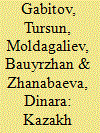

|
|
|
|
|
| Publication |
2013.
|
| Summary/Abstract |
This article focuses on determining the place and role of the Kazakh culture in the Eurasian civilizational area. It examines the choice of sociocultural development models for the Republic of Kazakhstan in globalization and localization conditions. The Kazakh culture is identified in the context of its interaction with the nomadic, Islamic, Russian, Central Asian, and East Asian civilizations. It analyzes the role of cultural factors in building the new post-Soviet Central Asian states.
|
|
|
|
|
|
|
|
|
|
|
|
|
|
|
|
| 8 |
ID:
127639


|
|
|
|
|
| Publication |
2013.
|
| Summary/Abstract |
Political development of independent Kyrgyzstan has been geared at democratization and the best possible form of governance. Under presidents Akaev and Bakiev, the semi-presidential system turned out to be a failure: in the course of time it degenerated into monopoly rule and usurpation of state power. The events of April 2010 opened a new stage in the republic's political development and created conditions for a semi-parliamentary form of governance.
This article analyzes the prospects for a parliamentary system in Kyrgyzstan, its weak and strong points, and its future. The author argues that despite its weak points, semi-parliamentary democracy will make the republic's political system more democratic.
|
|
|
|
|
|
|
|
|
|
|
|
|
|
|
|
| 9 |
ID:
127634
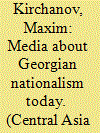

|
|
|
|
|
| Publication |
2013.
|
| Summary/Abstract |
The author analyzes the political and traditional trends in the ideology of contemporary Georgian nationalism. He concludes that it relies on a developed political tradition and is functioning as a primarily civil movement. The Georgian Orthodox Church is developing traditional forms of Georgian identity; the traditional trends in Georgian nationalism became even more obvious in May 2013 when sexual minorities stepped up their activities. Political debates about Georgia's role in the region and its relations with Russia have divided Georgian nationalists.
|
|
|
|
|
|
|
|
|
|
|
|
|
|
|
|
| 10 |
ID:
127640


|
|
|
|
|
| Publication |
2013.
|
| Summary/Abstract |
The authors analyze the far from simple development of Kyrgyz parliamentarism, the republic's experience of building the parliament (the Jogorku Kenesh) and its objective problems and shortcomings. The article is based on the personal experience of one of the authors who served as a deputy and speaker of one of the convocations and on the authors' scrutiny of the processes related to the parliament's activities.
|
|
|
|
|
|
|
|
|
|
|
|
|
|
|
|
| 11 |
ID:
127629


|
|
|
|
|
| Publication |
2013.
|
| Summary/Abstract |
The author analyzes the problems of Central Asian security and the role the CSTO and SCO play in ensuring it; he looks at the past, outlines the stages of building an efficient regional security system designed to oppose contemporary challenges, and concludes that regional integration as the only effective answer to the threats and challenges should be continued lest the region remains forever in an insecurity zone and falls behind the international community, which will deprive Central Asia of its chance for political and economic success.
|
|
|
|
|
|
|
|
|
|
|
|
|
|
|
|
| 12 |
ID:
127641


|
|
|
|
|
| Publication |
2013.
|
| Summary/Abstract |
This article examines the nature of the conflicts in present-day Central Asia (CA). It analyzes the main tangles in the border/territorial and land-energy disputes going on in CA against the background of the growing rivalry over regional resources.
It takes a look at the history leading up to the emergence of the conflicts in present-day CA and describes the main aspects of interstate relations among Tajikistan, Uzbekistan, and Kyrgyzstan. It takes the Sokh events (January 2013) as an example to show the specific features of the border conflicts in CA, comprised of the complex border configuration, the existence of enclaves, the exclusively high population density, the acute shortage of land and water resources (in the border zones), and the difficulties with forming a civil identity. Moreover, the unresolved nature of the border problems is giving rise to attempts at political manipulation.
Disputes over the use of transboundary river water are another unresolved issue that adds to the above-mentioned tension. An analysis of the sources of CA's hydropower industry helps to understand the nature of the water disputes in the region's countries and the consequences the Soviet irrigation traditions had for Tajikistan.
The different viewpoints on reviving construction of the Rogun hydropower plant, as well as the international experts' evaluation of its construction project supported by the World Bank are examined. The analysis has shown that the matter does not in fact concern the potential dangers of the Rogun hydropower plant project. The problem is rooted in the internal political contradictions inflicting CA: the rivaling elites are striving to privatize not only national, but also regional resources.
|
|
|
|
|
|
|
|
|
|
|
|
|
|
|
|
| 13 |
ID:
127631


|
|
|
|
|
| Publication |
2013.
|
| Summary/Abstract |
This article examines the general trends in the modernization strategy of Turkey's defense sector after the end of the Cold War, which, in addition to everything else, envisages the need for extensive renewal of the army. It pays particular attention to the role of Turkey's military and industrial complex in modernizing the country's armed forces, the main trends of which are identified on the basis of an analysis of official figures and indices. Modernization of the army and development of the military-industrial complex are largely aimed at meeting Turkey's geopolitical ambitions to become a more influential force in the region.
|
|
|
|
|
|
|
|
|
|
|
|
|
|
|
|
|
|
|
|
|